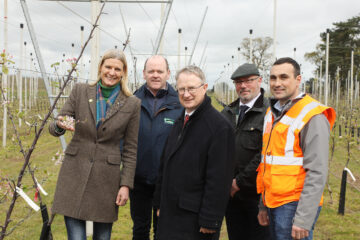Earlier this week, it was heard at the Teagasc National Outlook conference in Dublin that the average farm income in 2017 has increased by €8,400.
The reason behind this is improvements in dairy farming.
Dr Kevin Hanrahan, Head of the Teagasc Rural Economy and Development programme said:
“Overall average farm income in 2017 is estimated to have increased by about 30% to about €31,900, compared with €23,500 in 2016. This increase is driven largely by the improvement in dairy farm and to a lesser extent in tillage farm incomes.”
Farm milk prices in 2017 are up an estimated 30% on the 2016 level.
An extended period of slow growth in world dairy production created the circumstances for milk prices to improve during this year’s Irish milk production season.
Dairy farm input usage volumes have also risen, but this was anticipated given the increase in milk production nationally, estimated to be up by over 8 % this year. Family labour is not included in costs.
Teagasc Economist Dr Emma Dillon said that the average dairy farm income in Ireland in 2017 will exceed €90,000 – the highest ever figure – representing an increase of about €40,000 on the 2016 level. This is the return for the family labour employed in the business and a return on the land and capital assets utilised.
Beef farm prices improved as the year progressed. Spring prices for weanlings in 2017 were down on prices in 2016, but the improvement in finished cattle prices in the second half of the year has seen store cattle prices increase. Finished cattle prices over the year have also improved. With a benign input price environment Dr Jason Loughrey of Teagasc said that margins on single suckling enterprises in 2017 will remain stable, while cattle finishers will see an 8% increase in gross margin.
It was also a better year for pig farmers, who benefitted from significantly higher pig prices in the presence of stable feed costs.
Income on sheep farms also improved due to higher lamb prices and higher support payments.
2017 marked a partial recovery in incomes on tillage farms, as they experienced an improvement in cereal and straw prices. Growers in some regions, particularly in the North West of the country, experienced extremely difficult weather conditions at harvest.
Looking Towards 2018
Turning to 2018, the outlook for dairy is not as positive as for 2017, with a weakening in Irish farm milk prices of the order of 10% likely to take place as global milk supply growth begins to outpace milk demand growth. Milk production in Ireland will remain highly profitable however, and a further expansion of milk deliveries of 4% is envisaged in 2018.
Due to contracting EU beef supply, stable EU demand and strong world markets for meat, EU and Irish beef prices are forecast to increase modestly in 2018. Despite some increases in input prices, gross and net margins on both cattle rearing and cattle finishing farms are forecast to increase in 2018.
Margins and incomes on sheep farms are likely to drop back in 2018, as lamb prices are likely to be lower than in 2017.
Dr Fiona Thorne, Teagasc Tillage economist noted that the prospects for tillage farms will depend on the global harvest in 2018, and the impact that will have on cereal prices in Ireland. Barring adverse weather, tillage farm incomes in 2018 should be in line with 2017 levels.
In 2018 Irish pig producers will see their margins drop back due to lower pig prices.
Teagasc Economist Trevor Donnellan said that overall, average farm income is likely to be down in 2018 and is estimated to be just over €29,800. That would represent a 6% reduction on the estimated 2017 figure. However, this will still mean that the average farm income in 2018 will be among the highest experienced in recent years. The main reason for the anticipated decline in 2018 will be the drop in dairy farm incomes.
One area of concern for 2018 is the ongoing Brexit negotiation process. It is still too early to speculate whether or not developments in those negotiations will have a significant impact on the UK economy and demand for Irish agri-food exports in 2018.
Environmental sustainability measures were also addressed at the Outlook conference. While Ireland has achieved much in terms of measuring the environmental sustainability of Irish agriculture, Dr John Lynch of Teagasc indicated that there are a range of additional areas of sustainability that could be explored in the future.



